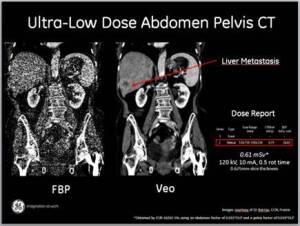by
Brendon Nafziger, DOTmed News Associate Editor | September 22, 2011

Veo allows lower-dose CT imaging (Credit: GE)
GE Healthcare said Tuesday it's received Food and Drug Administration 510(k) clearance for its Veo CT scanner technology, which uses new noise-canceling algorithms to take sharp images, sometimes at sub-millisievert doses.
The technology is a mix of the hardware that provides the computational power to perform the image reconstructions, and software that produces the image results.
In tests, under certain conditions, it can take a clinical chest CT scan that delivers about as much dosage as a chest X-ray, or about 0.05 mSv, according to radiologists at University Hospital in Brussels, Belgium, where a scanner employing the technology was previously installed.



Ad Statistics
Times Displayed: 656
Times Visited: 5 Fast-moving cardiac structures have a big impact on imaging. Fujifilm’s SCENARIA View premium performance CT brings solutions to address motion in Coronary CTA while delivering unique dose saving and workflow increasing benefits.
The hospital also said it could take CT scans of the stomach at 0.4 mSv, when from typical machines they're around 8 mSv.
“You can’t do the 0.05 mSv across the board for all exams, but it’s illustrative of the type of disruptive dose reduction that’s possible with Veo,” Scott Schubert, general manager for premium CT marketing with GE, told DOTmed News.
The technology uses GE's Model-based Iterative Reconstruction technique for eliminating noise, potentially letting doctors scan at lower dosages. Veo significantly expands on the iterative reconstruction technologies currently on the market. That is, it runs multiple reconstruction sequences, comparing the raw data captured by the scanner at lower doses against information that’s expected to have been there, given the scanning parameters.
But whereas earlier techniques made noise corrections based on statistical properties of the raw data, Veo ropes in a host of other factors, such as detector models, the geometry of the system and patient-specific features.
“By incorporating all those things into an improved model, it results in both improved dose performance and image quality,” Schubert said.
The technology’s available on the GE Discovery CT750 HD, released in 2009 in parts of the world. This scanner’s now available in the U.S., Europe, Canada and some Asian countries, GE said. Several hundred units have been installed worldwide, although adding the Veo, which became available in Europe and parts of Asia earlier this year, is optional.
GE declined to say how many sites had purchased Veo. But at least three sites in the United States are using it as part of a pilot study that started a few months ago, the first leg in a larger, multi-center, global clinical trial, which GE hopes to have wrapped up by the end of next year.
The company said the trial is exploring dose reduction capabilities, improved image clarity and physician confidence in the images.
“We’re optimistic about the results of that,” Schubert said. “It’s premature to say we’ve proven the sub-millisievert [scan], but we’ve got a lot of excitement.”

